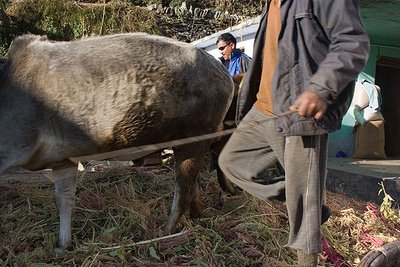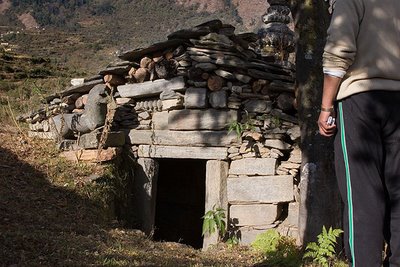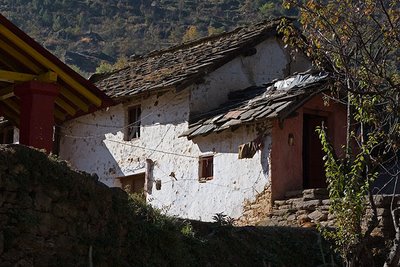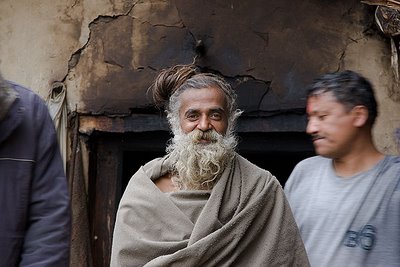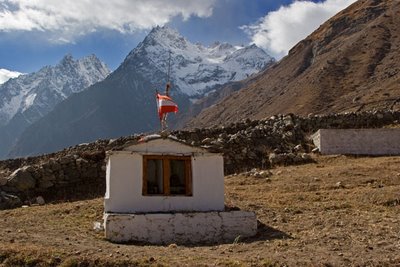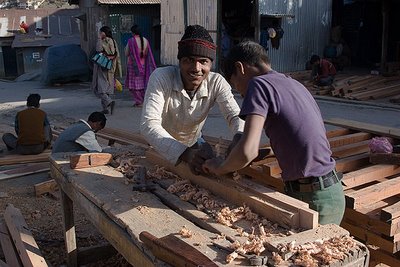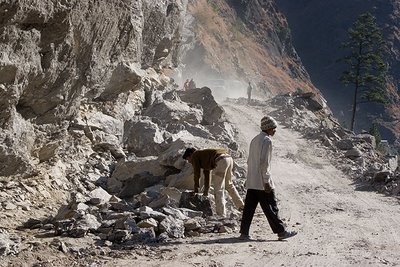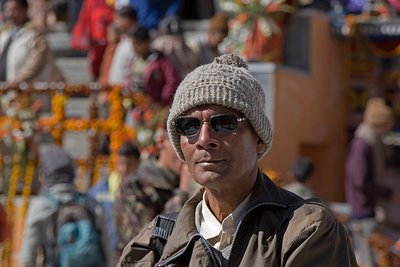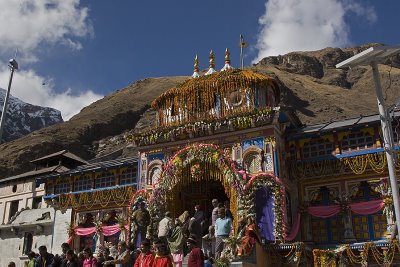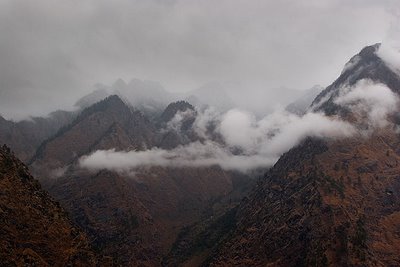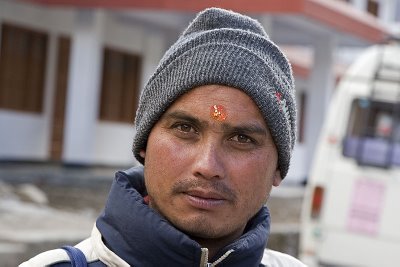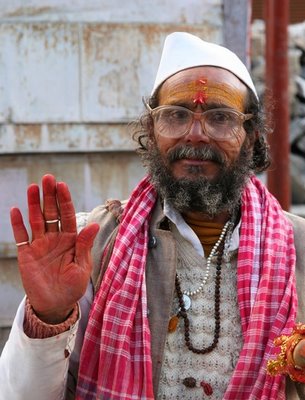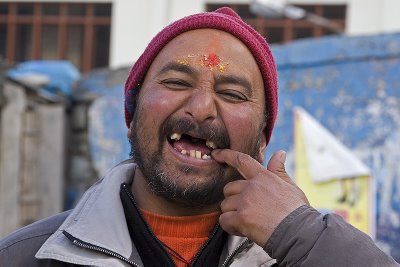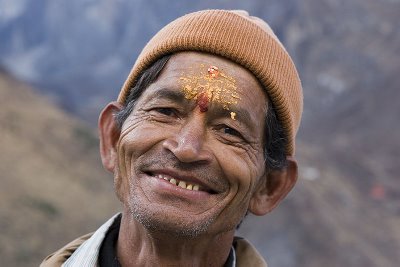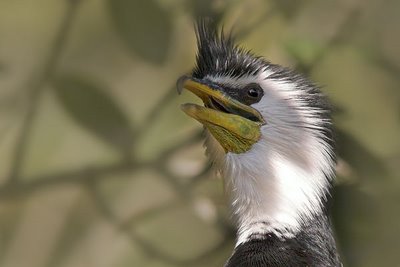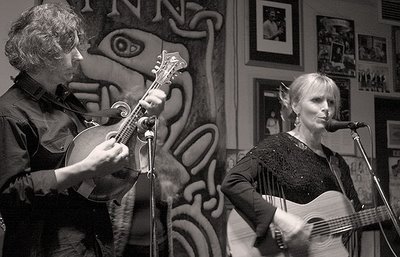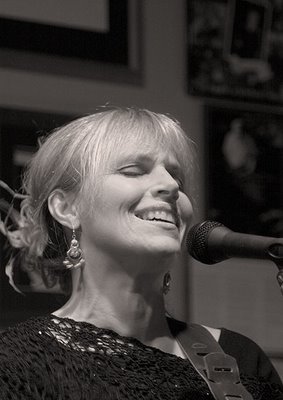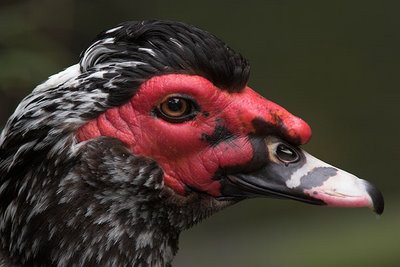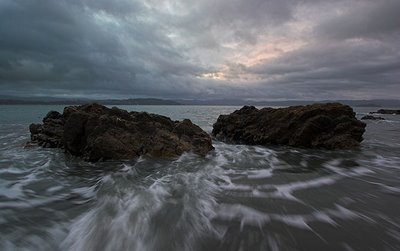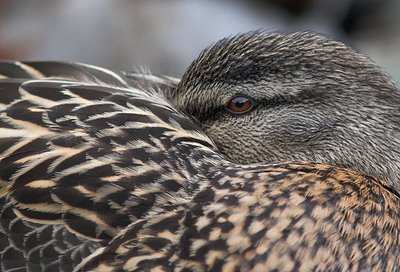 covered in forest — jungle, I suppose. An elderly woman sat next to me; later, another woman squeezed onto the seat next to her, but even with three of us on the seat I still enjoyed most aspects of the journey. Possibly the least comfortable was the volume of the music — the music itself I found pleasant enough but I began to wonder whether I'd leave the bus deaf or bleeding from the ears.
covered in forest — jungle, I suppose. An elderly woman sat next to me; later, another woman squeezed onto the seat next to her, but even with three of us on the seat I still enjoyed most aspects of the journey. Possibly the least comfortable was the volume of the music — the music itself I found pleasant enough but I began to wonder whether I'd leave the bus deaf or bleeding from the ears.Nevertheless, like most bus trips, this I found almost meditative. If I can look out a window there's so much to see, so many momentary images — a cow feeding by a sign saying "Himalayan Botanical Gardens"; the strange, semi-geometric shapes and red-brown colour of termite mounds in the forest; a langur sitting on a branch, silvery fur backlit against a dark valley so the animal looks haloed; the shimmy of a small lizard across a dusty shingle fan. All these things, so vivid at the time but when I try to remember them later, I've forgotten most. It's not just visual impressions though, nor impressions of any sense. As well those, I find ideas arriving — lots of ideas, things I realise, and in particular, much wondering.
Like how these buses become so battered. I have no idea how old they are, but they're all different manifestations of the same age — prehistoric. Or so they seem. I can understand how the exterior of the bus rapidly accumulates dents and scrapes, and how the rattles and bangs and squeaks develop, but how on earth does the interior of the bus come to look as if it's been filled with hammer-wielding rhesus monkeys?
They have a hard life, these buses. While waiting for mine to depart this morning, I looked across at the bus parked next to us. I realised the sides,
 beneath the windows, were spattered and streaked with dried vomit. I put my head out the window and checked my bus — it had the same adornment. I guess it's not just the buses that have a hard time on these hill roads.
beneath the windows, were spattered and streaked with dried vomit. I put my head out the window and checked my bus — it had the same adornment. I guess it's not just the buses that have a hard time on these hill roads.As we moved away from the mountains and descended rapidly, the haze over the lowlands became increasingly obvious. It also became clear — an exactly inappropriate word — that the haze wasn't solely or primarily a natural phenomenon; it had a dirty, slightly brownish hue. The extent and intensity of the pall appalled me. Some weeks ago, on one of the rare occasions I saw a few minutes of TV news, I saw a headline banner saying scientists have measured a local climatic effect from massive forest fires in South-West Asia. How must this shroud over India affect the climate?
At Kaladhungi the conductor pointed across the intersection.
"Museum," he said.
And there it was. Jim Corbett's house, his winter home. Two large busts, one on the lawn, the other on the verandah; several signs in English and Hindi explaining aspects of Corbett's life —his relationship with the villagers, the history of the house, etc. A large map of the region with information about the man-eaters he'd shot, with estimates of the number of people each tiger or leopard killed. I walked slowly around,
 through the house, trying to imagine what it was like when he lived here. Then, I suppose, it must have felt alive, functional, full of activity even if that activity was as quiet and still as Corbett reading and smoking, or sitting at a desk writing the books that made him famous. Or was it the books? Was it the events about which he wrote — the shooting of the man-eating tigers and leopards, the ending of terror — that made him famous? The books certainly made him famous outside the region, but there seems little doubt he'd still be remembered, and probably just as revered, within the region even if he hadn't written the books. Now his name's famous for other reasons too, primarily as the eponym for Corbett National Park; nor has it escaped the usual fate of famous names — it's used for all sorts of marketing. Arriving in Ramnagar, I peered out from the packed bus to see a billboard advertising, "Corbett plywood."
through the house, trying to imagine what it was like when he lived here. Then, I suppose, it must have felt alive, functional, full of activity even if that activity was as quiet and still as Corbett reading and smoking, or sitting at a desk writing the books that made him famous. Or was it the books? Was it the events about which he wrote — the shooting of the man-eating tigers and leopards, the ending of terror — that made him famous? The books certainly made him famous outside the region, but there seems little doubt he'd still be remembered, and probably just as revered, within the region even if he hadn't written the books. Now his name's famous for other reasons too, primarily as the eponym for Corbett National Park; nor has it escaped the usual fate of famous names — it's used for all sorts of marketing. Arriving in Ramnagar, I peered out from the packed bus to see a billboard advertising, "Corbett plywood."Inside the house, the quiet, stark rooms lacked much human feel. The clock hadn't been stopped here; it had continued ticking while Corbett had left, had been removed, then, eventually put back in the form of a few fragments — a few items of wooden furniture, a fishing net, the disintegrating remains of a mounted sambar. Tattered copies of his books with broken spines and simple title labels stuck to the coverboards. A camp bed. Supplementing these and similar items were photos and paintings depicting Corbett — referred to as "Jim" — and explanatory text about such things as his competence at carpentry and painting, at playing musical instruments like the flute and banjo, and his skill at taxidermy (although the only evidence — the sambar — seems to contradict this).
It's as if he's gone from the house in more than the literal sense. Where he truly continues to live is in his books and the appreciation of some of the local people; here I think particularly of the small, helpful man museum attendant who seemed concerned I'd understand the significance of what I
 saw, and looked after me well. For him, Jim Corbett still lived, still deserved a respect more meaningful than the mere recognition that his name could be used to sell plywood.
saw, and looked after me well. For him, Jim Corbett still lived, still deserved a respect more meaningful than the mere recognition that his name could be used to sell plywood.Tuesday 5 December 2006
Ramnagar. At a quarter to six the muezzin begins calling with tremendous volume, so intense the loudspeakers distort and crackle. I'm distant enough to be not bothered and in any case I'm already awake with a headache; besides, I actually enjoy the call. It reminds me I'm in a strange land — strange in the sense of utterly different from my own — and it makes me think about how seriously much of the world takes its religion. A slight feeling of respect for the strength of these beliefs; a hint of envy that I don't have my own beliefs that are as strong and certain (or do I?) — and a substantial amount of relief and a sense of freedom at not being fettered by them.
I also find it hard to feel entirely comfortable with the imposition of the muezzin's calls, at such amplified volume, on the entire area. I suppose from his perspective it's wonderful — if you follow Islam, you'll appreciate the calls; if you don't, you're punished for your disbelief. However, to me this is not a punishment. It's part of travelling; one way I learn to understand and appreciate how other people live. I, of course, will be moving on.
...
On the outskirts of Haldwani a man drives a mule-drawn cart with a huge load of sand; the effort to pull the ancient cart with its murderous load must be enormous, but this is not good enough for the driver. He raises a
 long, weathered leather strap and flogs animal brutally. I can clearly see it's lame; it drags its right hind leg as if the limb's useless; the beast has its head twisted to one side as it struggles along the road. He lashes it again. We drive past, on into the hills and back towards Naini Tal.
long, weathered leather strap and flogs animal brutally. I can clearly see it's lame; it drags its right hind leg as if the limb's useless; the beast has its head twisted to one side as it struggles along the road. He lashes it again. We drive past, on into the hills and back towards Naini Tal....
Two heavy tow trucks retrieve pieces of wreckage from the road and over the bank. Whatever the vehicle was — bus or truck — it's unrecognisable now. A piece of heavy steel rod with a large cog on one end sticks up from the tarmac in the middle of the road, where it has impaled itself with tremendous force. What happened? Did the brakes fail on this steep, winding road? Could anyone have survived this? How often does this happen?
Wednesday 13 December 2006
With the aid of a loperamide pill at the start of the journey and another some time in the wee hours of the morning, I survived the nine hour journey in the "luxury bus" from Naini Tal to Delhi. Despite the cramped seat — the man in front had pushed his seat back to recline hard against my knees — I slept off and on for much of the night, although it grew very cold and by dawn my legs and feet were badly chilled. I was also wondering what had happened to the luxury bus's rat, which had woken me some time during the night as it crawled across my thigh.
Thursday 14 December 2006
Back in Parharganj in Delhi, the hotel manager recognises me and I don't need to fill in all the bureaucratic details in the register, as he'll transfer them from my last stay. He asks if I've collected the parcel I left over a month ago. The travel man greets me and asks how I got on, so I list the places I've visited since leaving.
 He looks pleased. I eat lunch at my little stall and the young waiter recognises me and looks after me. I know my way around; I know a little of how life works here; I feel relaxed and comfortable. Some people here know enough about me to recognise me and remember to ask, for example, whether I want plain or butter naan this time. Little by little, a tiny part of Delhi has begun to recognise me.
He looks pleased. I eat lunch at my little stall and the young waiter recognises me and looks after me. I know my way around; I know a little of how life works here; I feel relaxed and comfortable. Some people here know enough about me to recognise me and remember to ask, for example, whether I want plain or butter naan this time. Little by little, a tiny part of Delhi has begun to recognise me.Sunday 17 December 2006
The pressure of lives here may be what I'd most struggle to accept. I try to imagine Paharganj with only 1% of its population — the alleys empty, the stalls unstaffed, clothes and bags and scarves hanging untouched, no rickshaws save for one every 10 minutes or so, no din, no horns. Someone disappearing around a corner at the far end of the lane. A face looking out from behind a half-open door. No one else. The silence. What would this be like? How would I feel, walking along Main Bazaar with only a few dozen other people? Relieved, relaxed, unhurried, and unpressured? Or would I miss the energy and excitement, the vibrancy — and the anonymity? In a largely depopulated world like that it would be hard not to stand out, simply because you're a significant proportion of the population. Of course, it's likely I'll always stand out here, being tall, white, and blue-eyed. I was going to say thin, also, but if anything, that helps me blend in.
I can cope with extreme crowding when I have to; I can even enjoy it, as I did on the bus from Kaladhungi to Ramnagar, but what I doubt I could endure is sustained crowding, the unrelenting pressure of other people all around me. How much of that discomfort arises from the the presence of other people and their effects and how much is the absence of wildness? These, of course, might just be different ways of saying the same thing, but to me they feel different. I'm enjoying — mostly — where I am right now, whatever I'm doing, but even when I'm relaxed, I realise I'm reminding myself to relax and enjoy it; with a few memorable exceptions, the enjoyment's deliberate, it differs from that spontaneous joy which appears suddenly and inescapably when I'm somewhere wild, or at least in the presence of that wild quality. It's nothing like the feeling that arises and
 can almost overwhelm me when I finally understand I'm somewhere remote — somewhere that feels not just beyond the easy reach of the nominally civilised world, but where I feel as if I've stepped aside from time.
can almost overwhelm me when I finally understand I'm somewhere remote — somewhere that feels not just beyond the easy reach of the nominally civilised world, but where I feel as if I've stepped aside from time.In that respect I wonder whether that quality of remoteness is a function of how easily one finds reminders of the present; in other words, the easier it is to remember in what era you're living, the less remote you feel? A plastic bottle on a beach; a laminated map on the polyurethaned plywood wall of a Ruahine hut; a lost and weather-ravaged running shoe bearing the Nike logo on a riverbank in Mongolia. A cellphone ringing at Badrinath. Each of these things places you in the last half century — some in the last decade. Remoteness is not just distance in space, it also has a temporal aspect.
...
Saturday 16 December 2006
What is it like to be born into an environment where you're never more than a few metres from another human being; where the air you breathe seems to be as much dust and fumes as nitrogen and oxygen; where each day your ears become a little more desensitised to the din; where the only time you see extensive green fields is on your rare excursion out of the city; where your world comprises wall and wires, concrete and compacted dirt, cars and buses and rickshaws and scooters and motorcycles, dogs and cows and their shit, ubiquitous litter, and always other humans — and their shit? What is it like to grow up in an environment like this, and to see people from foreign lands walk along your streets and buy things you can't afford, eat in restaurants you can't afford; to know these people live in the countries you see on TV, in the kind of luxury you know you'll almost certainly never enjoy? They come, they look, they buy. They form opinions and make judgements. They leave.
If I differ in any respect from these kinds of foreigners, I suspect it's in two main ways — I buy less, and I'm slower to form opinions, more reluctant to make judgments, preferring instead to wonder. This is my impression, but I might be wrong; others might see me differently.
Friday 22 December 2006
Reclining on the comfortable chaise-lounge at the Kiran Guest House in Bharatpur, reading and thinking. Krishnamurti; his ideas about freedom from ideas, the importance of observation without interpretation, the need for relationship with nature as a prerequisite for relationship with people. Meanwhile, an elderly woman, bent double, whisks the area, sweeping the dust, looking after the home, keeping it clean and neat for the guests. Working while I lounge and relax. This is what it is to be lucky, to be privileged. Those who insist you make your own luck ignore the greatest luck of all — to be born; in particular, to be born into a life like mine.
All I can do is smile at her, acknowledging the work she's doing so well.
She smiles back at me.
Christmas Day, 25 December 2006
Keoladeo Ghana National Park [1] in the late afternoon; the sound of twigs snapping, branches being broken. Not by chital, not by sambar.
 Not by nilgai. Not even by cattle. By humans, by women collecting firewood. Incrementally, load by load, they remove the park. Slowly they're burning the park — not in situ but in hundreds of nearby homes each night. The smoke from the fires adds to the smog enveloping India; the smog hastens the warming of the Earth, which affects climate patterns. I'm told the monsoon has been poor here for the last two years. The wetlands are desiccated and dusty, the birds much less abundant. Most of the migratory birds fail to arrive.
Not by nilgai. Not even by cattle. By humans, by women collecting firewood. Incrementally, load by load, they remove the park. Slowly they're burning the park — not in situ but in hundreds of nearby homes each night. The smoke from the fires adds to the smog enveloping India; the smog hastens the warming of the Earth, which affects climate patterns. I'm told the monsoon has been poor here for the last two years. The wetlands are desiccated and dusty, the birds much less abundant. Most of the migratory birds fail to arrive.Four rose-ringed parakeets race across the rose-tinged evening sky. I've been stalking jackals for much of the time I've been in the park this afternoon. Now it's twilight; I walk back along the road and three jackals cross in front of me. They don't see me until I'm half the distance I'd managed earlier in the day. A chital stag whips up his head in alarm. Big antlers in velvet; the beautiful, white-spotted coat. He stares at me, then bounds off, from just 30 metres away. A nilgai bull, the same short distance away, watches him but seems unaware of me. I have become part of the forest, another obscure shape in the almost-gone light.
A little way further on, a file of strange, grey shapes in the dusk. The closest, at the head of the line, steps forward and snuffles the air. Wild boar.
 The night becomes tense. After I move on, they cross the road behind me, quickly, still maintaining their single file, and disappear into the dry, low forest.
The night becomes tense. After I move on, they cross the road behind me, quickly, still maintaining their single file, and disappear into the dry, low forest.Who owns this land? To whom does it belong? Do these questions even make any sense?
Sadly, I think "ownership" in this context too often means the claimed right to exploit, and often to desecrate. In fact, I find it easier to understand how the land might own those who live with it than to accept the converse.
But, as usual, this perspective sees "the land" and "those who live with it" as separate — but who are the latter? Humans only? Birds, deer, fish, reptiles, insects, spiders, and all those other animate lives? Plants? The distinction seems arbitrary, spurious. The only unique claim humans might have is that we can choose to desecrate the rest, and in doing so, we we contribute to our own destruction. We are less separate than we think. This is most clearly understood by thinking of the land and its inhabitants not as "stuff" — not as objects — but as interacting processes, as relationships.
Thursday 28 December 2006
The cycle rickshaw ride from the guest house to the bus station offers its share of interesting sights. The birds, of course — red-wattled lapwings, a coot, egrets, others I subsequently forget. A man washing his laundry in one of the roadside ponds — in stagnant, festering water that looked like sewage. Spreading something to dry in the breezy sun. A dog, crushed flat on the road; a rag of skin, paws attached, everything else broken and formless, house crows tugging at guts withering in the heat. A guest house advertising a "specious lawn for camping sight." And signs advertising "ACC." I have no idea what this means, but reflexively think of New Zealand's Accident Compensation Commission —
 the conditioning again. What must it be like to see these things through the eyes of someone who's never seen anything else? For such a person, how strange must New Zealand seem?
the conditioning again. What must it be like to see these things through the eyes of someone who's never seen anything else? For such a person, how strange must New Zealand seem?I sit in the rickshaw, slightly surprised by the the chill of the breeze, although it's already mid morning. Thinking of the friends I'm leaving behind at the Kiran. They told me when I arrived that they wanted me to feel like a guest in their home, and that's how I've felt. This morning Ashok sat and chatted with me at breakfast, in his rudimentary English — far superior to my few words of Hindi. I asked him when his little boy would start school. He already has, Ashok conveyed, although the wee boy's less than 3 1/2 years old. We'd met him yesterday when Neil, Andrew, and I accepted Ashok's invitation to visit his home for chai. Andrew tried to entertain the little fella with armpit farts but got no response.
"It seems to amuse the kids in Nepal," he said.
Ashok sat with me as I finished breakfast. He gestured to himself.
"Miss," he said, and gestured towards me. "Seven days."
Yes, I'll miss him too.
Notes:
1. It's pronounced "KEV-lah-dev".
Photos (click to enlarge them):
1. Langur, Semnopithecus sp., at Naini Tal, Uttaranchal.
2. Rose-ringed parakeet, Psittacula krameri. Keoladeo Ghana National Park, Rajasthan.
3. Oriental magpie robin, Copsychus saularis. Keoladeo NP.
4. Brahminy starling, Sturnus pagodarum. Keoladeo NP.
5. "There's something tasty down there." Palm squirrel, Funambulus sp., Kolayat, Rajasthan.
6. Old Delhi.
7. Female snow leopard, Uncia uncia, Naini Tal zoo. CAPTIVE ANIMAL.
8. Chital, Axis axis, Keoladeo NP.
9, 10. Golden jackal, Canis aureus, Keoladeo NP.
Photos and words © 2007 Pete McGregor










